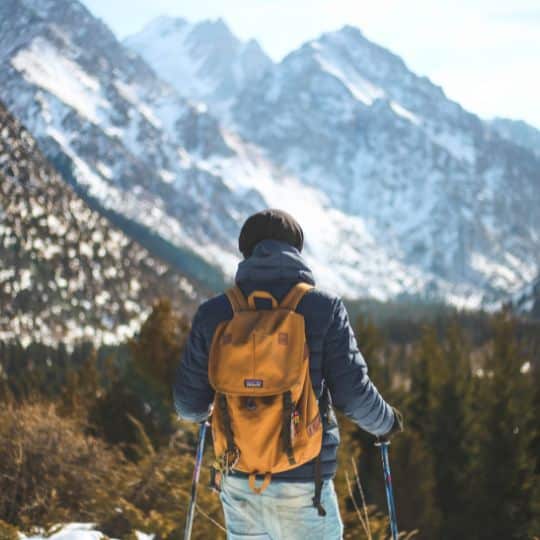Mount Kenya was formed through the geological forces that actually shaped East Africa millions of years ago.
This extinct volcano was last active in the Pliocene epoch with the last activity estimated to be between 3.1-2.6 million years ago and is currently a dormant strato volcano. Scientists conclude that at the start of its eruptions, Mount Kenya stood at roughly 6500m, and was among the largest volcanic structures ever to emerge on the surface of our planet.
The mountain is in a present geological shape that was formed through many years of erosion and glaciation processes. The foundation of this geographical wonder is made up of volcanic stone in particularly nepheline syenite, phonolite, and kenyte.
Owing to actions of erosion occasioned by wind, water, and ice, gorges and ridges have been conspicuous features on the mountain’s slopes.
Today, the summit of Mount Kenya has 12 inactive glaciers that are melting fast because of global warming. Batian with a height of 5,199 meters and Nelion with a height of 5,188 meters are technical climbing activities that remain attractive to mountaineers.
The third highest peak is Point Lenana which stands at 4,985 meters and is commonly used by trekking enthusiasts due to the good views of the region.
The presence of the mountain was also responsible for forming many glacial tarns and the magnificent U-shaped valleys. Together with the background of the towering mountain, these features present one of the most magnificent sceneries in East Africa.
Diverse Ecosystems

From when you climb up Mount Kenya you will be able to see changes in the vegetation cover with every change in altitude as the climate changes. One of the intriguing features of the mountain involves the vertical zonation of these habitats that help support a myriad of flora and fauna.
- Lower slopes (1,800-2,500 meters): The lower slopes are dominated by closed montane forests; some of the tree species include Juniperus procera (African pencil cedar) and Podocarpus latifolius (yellowwood). Wildlife can be also observed in this zone where one may see elephants, buffalos, and several types of birds. The forest is closely involved in water catchment for water supply to the surrounding areas.
- Bamboo zone (2,500-3,000 meters): Succeeding the montane forest zone there is another zone characterized by Yushania alpina (African alpine bamboo). This appears unique in offering both food and shelter for many animals; specifically, it is home to the endangered mountain bongo antelope. The bamboo helps in the purification of the water since it also plays an important role in water catchment for the whole of Kenya, especially in this mountainous region.
- Alpine zone (3,000-3,500 meters): Moving up the terrain, the plant cover goes from the subalpine zone, comprising of opening in the forest, alpine meadow, moor, and tussock grassland. This zone comprises of large castor oil plant/ groundsel (Dendrosenecio giganea) and lobelia some of which grow to about 3m in height. These plants have also adapted special mechanisms to deal with differences in temperature in addition to high ultraviolet radiation.
- Afro-alpine zone (3,500-4,500 meters): This zone is known to have some of the most beautiful as well as strange vegetation on Mount Kenya. The otherworldly tall rosette plants these include; Lobelia telekii and Lobelia keniensis are key species in the plant’s biome. These plants have acquired a “giant rosette” form of growth and antifreeze proteins in their foliage as a survival measure to do away with unfavorable climates. It also hosts specialized animals such as the Mount Kenya hyrax and the mountain mouse shrew.
- Nival zone (above 4,500 meters): The summit area of Mount Kenya has rocks, ice formations, and very scanty plant life. This zone include glacier which is important water supply for the surrounding environment of the mountain. At this altitude, the vegetation cover is considerably low and only some lichens and mosses can survive in this harsh climate.
Due to this kind of ecosystem, Mount Kenya are considered as a home of various biodiversities. Most flora and fauna in this park are either the montane endemics or the highland endemics originating from the eastern part of Africa and have adapted to the environment in this region over the years.
These aspects of life forms and the geographical structure of Mount Kenya contributed to its recognition as a UNESCO World Heritage Site in the year 1997.
In fact, the ecosystems of the mountain are also useful to Kenya in other ways including, water cycling. The forests and vegetation received moisture from the wet clouds as well as the availability of glaciers in the area helped supply water during dry seasons.
This makes it important that Mount Kenya serves as a water tower supplying several big river systems that support millions of people and wildlife habitats in the lowlands.
Animals in the Mount Kenya National Park
Mammals
The park is home to a rich variety of wildlife, including:
- Elephants
- Black rhinoceros
- Cape buffalo
- Giant forest hog
- Tree hyrax
- Leopards
- Suni antelope
- Black-fronted duiker
Birdlife

This mountain is home to as many as 130 different bird species, thus making it a birding enthusiast’s paradise. Some notable species include:
- Green ibis (local Mount Kenya race)
- Ayres hawk eagle
- Abyssinian long-eared owl
- Scaly francolin
- Rüppell’s robin-chat
- Various sunbird species
Activities in Mt Kenya National Park
Mountain Climbing
A popular activity that is completed in the park is climbing Mount Kenya. There are several routes to choose from, catering to different skill levels:
- Naro Moru Route: The easiest and the most preferred
- Sirimon Route
- Chogoria Route
- Burguret Route
- Timau Route
Hiking and Nature Walks
For those who do not want to reach the top of the mountain, there are a lot of trekking routes and nature walks that provide breathtaking landscapes and fauna views.
Game Drives
Take a game drive on the foothills of the mountain and there are possibilities of seeing elephants, buffaloes, and several species of antelopes.
Bird Watching
Since the park hosts a variety of ecological zones, the Mount Kenya National Park is also a bird watchers’ paradise.
Camping
Engage in camping in one of the campsites within the park and get a closer view of the park’s wilderness.
Recommended Time to Visit Mount Kenya National Park

The park is open year-round, but the best time to visit depends on your planned activities:
- Climbing: The dry seasons are from January to February and July to October for those who prefer climbing during this season.
- Wildlife viewing: The dry season is from June to October and that is the time that people and animals may be found close to water sources.
- Bird watching: This destination is good for visiting from November to April because it is home to migratory birds.
How to Get There

Mount Kenya National Park can be found approximately 175km northeast of Nairobi. You can reach the park by:
- Road: It will take about 3-4 hours’ drive from Nairobi.
- Air: Reach at Nanyuki Airstrip and its takes one one-hour drive to reach at the park.
In conclusion, culturally, Mount Kenya has a significant place in the lives of the Kikuyu and Meru people. They hold a conviction that their God, Ngai, and his wife Mumbi live on this mountain summit. Today, many of the older tribal activities and events continue to take place on the slopes of the mountain.
This park provides a natural paradise for those interested in either nature or adventure or even history and culture. Packed with an extensive variety of biomes and animal species, impressive geological features and rocks, and steep trails, the park can suit any visitor’s preferences. When you choose to come to this impressive place, you not only receive many impressions but also help to preserve one of the richest gifts of Africa.







